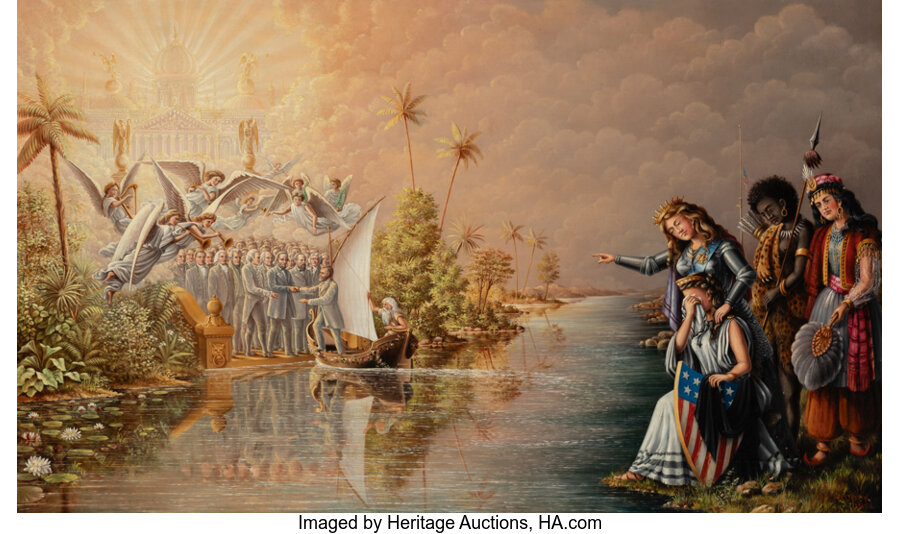Signed and dated lower right: TF. Laycock / 1886
Private collection, Beverly Hills, California.
Thomas F. Laycock (American, 1840-1898) Crossing the River, 1886 Oil on canvas 36 x 60 inches (91.4 x 152.4 cm) Signed and dated lower right: TF. Laycock / 1886 PROVENANCE: Private collection, Beverly Hills, California. LITERATURE: Daily Nevada State Journal, July 1, 1886. Rich in detail and peppered with traditional references, the present work offers a tantalizing glimpse into the life of a largely unknown artist. Little is known about the early life of British-born Thomas F. Laycock until his period of service to the Union during the American Civil War. As a naval serviceman, he was present at the fall of Fort Fisher outside of Wilmington, North Carolina, and in the first known record of him as an artist, his sketch of the fort's bombardment became the basis of a widely circulated lithograph published by Endicott & Co., New York, in 1865. Following his honorable discharge from the miliary in December of 1865, Laycock headed west, settling in Reno, Nevada by 1879. (Reno Evening Gazette, Vol. 8, no. 10, October 11, 1879) In Reno, Laycock honed his gift for painting, exploring all manner of subjects and working on a grand scale. His only known extant landscape, a view of Yosemite Falls from circa 1800, resides in the collection of the National Park Service; at approximately 48 x 35 inches, it represents the smallest of his known works. The present lot, Crossing the River, executed on an even larger scale in 1886 to memorialize the 1885 death of former President Ulysses S. Grant, was received with surprisingly little enthusiasm. Writing for the Carson Appeal in 1886, one critic said of the painting, "The group of departed great men are all in swallow-tailed coats, surrounded by angels in white wings, and waiving palms. Doubtless the artist intended to pay a tribute to the dead but in doing so put together and incongruous mixture of commonplace with the ideal. Angels with white wings do not go with men in black dress coats." (Daily Nevada State Journal, July 1, 1886) The modern viewer, however, notes the ignorance of the declarations spouted by the unnamed critic from Carson. Tremendously detailed and highly finished, Crossing the River stands as a remarkable surviving example of Laycock's style, and while it's unknown whether Laycock ever received formal artistic instruction, the myriad details poured into the composition clearly indicate that Laycock was the recipient of a classical education. The figure of Grant is ferried across the river by the Boatman of antiquity, characteristically depicted as he appears in both Virgil's Aeneid and Dante's Inferno: an old man with an unkempt beard, dressed in tattered robes. Charon's typical shallow-draft skiff with its curved prow receives a 19th century upgrade with the addition of a rudder and sail. In a nod to Christianity's strong emphasis on physical positioning, Laycock locates the heavenly Capitol Building at the viewer's left, his unique version of the Kingdom of Heaven. The dexter side further acts as a showcase for Laycock's skills as a portraitist; beyond the immediately recognizable figure of Abraham Lincoln, reaching out to reunite with his old friend after twenty years, at least ten other former presidents can be easily identified. Additionally, Laycock demonstrates a familiarity with traditional iconography, drawing from Cesare Ripa's Iconologia, a mainstay in the reference libraries of artists from the 16th century and beyond, and whose figures of the Four Continents are readily identifiable in the secondary tableau at the viewer's right. Asia, her costume richly embellished with jewels and silks, the luxuries of trade, stands beside the warrior Africa, a tall dark-skinned woman draped in the pelt of a leopard, one of the exotic, formidable dangers of the continent. Europe, crowned "Europa regina" and fitted in armor, points to the welcoming congregation up river to comfort the weeping America, the only figure who deviates notably from Ripa's tradition. America, whose previous depictions focused on the wildness of the land and the pervasive western perception of indigenous populations as "uncivilized," is presented in a decidedly different form, the personification of America the nation rather than America the continent. "Columbia," a young woman clothed in the white robes of innocence, falls to her knees while covering her face as she sobs, clutching the nation's seal, partially covered in the black veil of mourning. Altogether, the composition is remarkably complex, referencing traditions from Christianity, the Renaissance, and the antique, even incorporating a contemporary perspective on American identity. This depth was lost on the Carson critic – whose nonsensical gripe regarding the mixture of common and ideal betrays an ignorance of the extensive use of that very combination throughout the previous centuries of European art – but is sure to find renewed appreciation amongst the scholars and connoisseurs of today. HID12401132022 © 2024 Heritage Auctions | All Rights Reserved
Lined canvas. Under UV exam, there appear to be minor touches of inpaint along the edges of the canvas. Two small 1/2 inch flecks of loss in the lower right corner with accompanying inpaint along edges of loss. Small 2 1/2 inch vertical area of retouching in the animal print dress at right. 6 inch vertical line of inpaint in the building at upper left. Small 1 inch dot of inpaint in the upper corner of the sail. A few small touches of inpaint in the sky. Faint and thin 3 inch scratch through the spear in upper right.
Framed Dimensions 53 X 77 Inches

